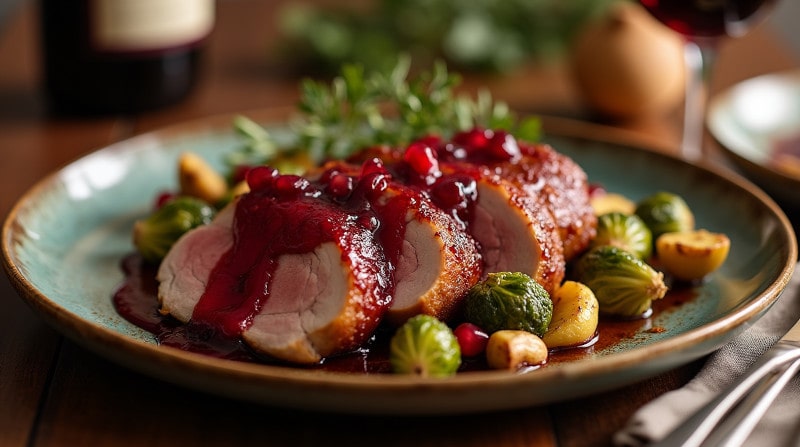An elegant dish for the cold season: Crispy roast duck breast, refined with a fruity and tangy pomegranate ice cream, served with seasonal winter vegetables – this recipe combines strong flavours with sweet and sour nuances. The combination of duck meat, pomegranate & spices requires a wine with freshness, elegance & structure.
➡ But which wine goes best with it? In this article, you’ll find out why a Syrah, a fruity Merlot or a velvety Pinot Noir are perfect for this dish. 🍷🦆
🍷 Perfect wine pairing for duck breast with pomegranate ice cream
Why is duck breast with pomegranate ice cream a particular challenge for wine pairing?
The combination of crispy skin, juicy meat & sweet and sour sauce brings several layers of flavour into play: ✔ Oily, crispy texture (duck skin & meat) ✔ Sweet and sour freshness (pomegranate ice cream) ✔ Strong roasted flavours (winter vegetables & duck breast)
➡ The wine must have enough acidity to cut through the fat of the duck, but also enough fruit to keep up with the pomegranate ice cream.
1. syrah (e.g. Rhône or Australia)
✔ Warum passt es perfekt?
- Peppery notes & dark fruit (blackberry, plum) harmonise with the ice cream
- Strong structure & silky tannins balance the duck fat
- Fine spice complements the roasted flavours
➡ Tip: A Côte-Rôtie Syrah from France or a Shiraz from Australia provides just the right combination of fruit and flavour.
2. merlot (Bordeaux or California)
✔ Why does Merlot work so well?
- Soft tannins & fruity elegance emphasise the duck breast
- Flavours of cherry & cassis complement the pomegranate ice cream perfectly
- Good balance between fullness & freshness
➡ Tip: A Merlot from Bordeaux or a Californian Merlot with a little oak is an excellent match.
3. pinot noir (Germany or Burgundy, France)
✔ Why is Pinot Noir an elegant choice?
- Light tannins & red fruit (raspberry, strawberry) complement the pomegranate sauce
- Fine acidity structure ensures freshness & elegance
- Fine acidity structure provides freshness & elegance Medium body & silky texture are ideal with duck breast
➡ Tip: A Pinot Noir from Baden or a Pinot Noir from Burgundy offers a sophisticated red wine option.
Duck breast with pomegranate ice cream & winter vegetables
Cooking utensils
- 1 Pan for the duck
- 1 Pot for the pomegranate ice cream
- 1 Oven for the vegetables
- 1 Cutting board & knife
Ingredients
For the duck breast:
- 2 Duck breasts (approx. 200 g each)
- Salt & black pepper
- 1 TL Thyme (chopped)
For the pomegranate ice cream:
- 150 ml Pomegranate juice (fresh or direct juice)
- 50 ml Red wine (e.g. Syrah or Merlot)
- 1 EL Honey
- 1 TL Balsamic vinegar
- 1 TL Butter
For the winter vegetables:
- 200 g Brussels sprouts (halved)
- 1 Parsnip (cut into fine strips)
- 1 EL Olive oil
- Salt & pepper
Preparation
- Prepare winter vegetables:Season the Brussels sprouts & parsnip with olive oil, salt & pepper. Roast in the oven at 180°C for approx. 20 mins.
- Roast the duck breast:Score the skin with a sharp knife and season with salt and pepper. In a cold frying pan over a medium heat Fry on the skin side for 5 minutes until crispy. Turn & fry on the meat side for 2 minutes. Bake in the oven at 150°C for approx. Cook for 8-10 minutes.
- Make the pomegranate ice cream:Reduce the pomegranate juice, red wine, honey & balsamic vinegar in a small pan.Reduce until a syrupy consistency is achieved.Mount with butter to create shine & creaminess.
- Serve:Slice the duck breast and drizzle with the pomegranate ice cream. Arrange winter vegetables next to it

